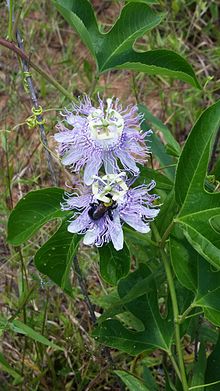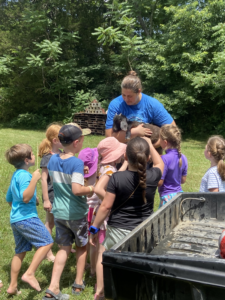
The Wonder of Passion Flowers
The first time I saw a Maypop flower I thought it looked like something from an alien planet. The small vine grew in the corner of an old garden and was hardly noticeable except for the vibrant purple flower popping out from the dark green leaves. There were odd-looking spikey caterpillars all over it, so I wanted to learn more. Maypop has now become one of my favorite native Tennessee wildflowers and I am thrilled to have it covering the front fence in the children’s garden at Stoney Creek Farm. Not only is this unassuming ‘weed’ a very important and wonderful addition to any garden or landscape, but it is also a vital resource for pollinators. So let’s talk about the wonder of passion flowers!
What is a Maypop?
The name “Maypop”, also known as Passionvine, Purple Passionflower, True Passionflower, Wild Apricot, (or more specifically Passiflora Incarnata), may have been given to this plant because it pops up from the ground in May. Or perhaps it is because the fruit will pop open like an overstuffed balloon when fully ripe. Related to the tropical “Passionfruit” found in places like Hawaii, this is a native variety found right here in the South. Whether you call it Maypop Passionvine, or one of its many other names, there is no mistaking that this plant deserves much more than the title of “weed” it is often given. As a fast-growing perennial vine with climbing or trailing stems, Maypop grows one of nature’s most delicious and perhaps least-known native fruits.
Maypop Fruiting and Jelly
Maypop fruit becomes ripe near the end of August or early September and can be eaten right off the vine. Also, it can be used in delicious recipes such as Maypop jelly. The unassuming fruit grows to be about the size of a chicken egg with a tough green exterior. The juicy seeds inside the fruit are similar to pomegranate arils.
When is a Maypop Ripe?
If picked too early the fruit will be unripe. Immature maypops have an extremely hard, dry exterior. When the unripe fruit is torn open there is only dry, white rind and unmatured seeds. The delicate fruit takes time to ripen, but oh boy is it worth the wait! When Maypop fruit is heavy on the vine, very squishy, has a strong sweet smell, and is easy to pick. The ripest fruits may have already fallen to the ground, heavy from the weight of the juicy fruit inside. Maypop does not ripen all at once but rather becomes ripe one fruit at a time throughout the last weeks of summer. Fun fact – one year I entered a jar of Maypop jelly at the Tennessee State Fair with a group of elementary school kids and we won first place! See my recipe below!
Important for Pollination
Let me encourage you to think about incorporating native plants and wildflowers, such as Maypop, into your Summer Garden These plants are vitally important to our region! It is a known fact that the more flowers incorporated into a garden, the more pollinators will appear. A great example of the urgency for pollinator plants is the plight of the Monarch butterflies and their decline over the years. Organizations such as Pollinator Partnership work hard to educate the public on the importance of planting varieties of milkweed in gardens. These ‘waystations’ for the Monarchs, serve a great purpose because milkweed is this butterfly’s host plant. This is one of the reasons why I advocate for allowing Maypop a dedicated space in your garden or landscaping.
Only Host for the Gulf Fritillary Butterfly
Maypop is the only host plant for the Gulf Fritillary caterpillar, which becomes the beautifully vibrant orange and brown Gulf Fritillary Butterfly. In its caterpillar stages, the Gulf Fritillary looks almost frightening as its spike-covered appearance looks like it could really hurt if touched. Good news – – these spikes are only a mimicry defense to keep away predators. The spikes on the Gulf Fritillary caterpillars are actually soft and flexible, and it is not harmful to hold them.
Teach Caring for the Environment
In fact, I recommend studying this beautiful butterfly as an excellent way to teach young children about life cycles and caring for the environment. I have seen time and again the delight on a child’s face as they hold these magnificent-looking caterpillars or marvel in awe at the mesmerizing appearance of the vibrant purple flowers of the Maypop. We often challenge children to taste the sweet fruit right off the vine. While some don’t care for the taste, most children are pleasantly surprised and often can’t wait to share their discoveries with their parents.
Discover Maypops When Hiking
When traveling along the backroads of Tennessee or visiting the many hiking trails, search for Maypops. The deep green leaves and curling vines of this native plant will be evident. The delicate tendrils wind their way around fence posts, climb up roadside signs, and sprawl along sides of highways much, in the same way, invasive Kudzu does. These plants are often overlooked along with other common weeds such as Dandelion and Chickweed, often mowed over, considered a nuisance, or worse – sprayed with herbicide. It is said that as you learn to know better, you learn to do better. Join me in taking time to appreciate this amazing “weed”, and remember it, too, has an important place in our ecosystem.
Want to Learn More?
Attend a class on Gardening with Native Plants with Margie Hunter, botanist, author, and speaker. Margie can teach you all about native plants in Tennessee and how our community can improve the ecosystem in every backyard!
MAYPOP JELLY RECIPE
Written in the way my grandmother would, without proper measurements but with more of a general recipe to go by and turn into your own masterpiece (a smidge of this, a pinch of that, etc.)
Pick very ripe Maypop fruits and gently wash them in cold water. Chop whole fruits (including rinds) into small pieces in a large bowl and mash with a potato masher. The goal here is to mash as much juice from the fruit as possible. Take your time with this step as the longer you mash, the more juice you will get. Using cheesecloth, drain the juice and discard or compost the remaining bits. Combine 1 part juice to 1 part sugar and bring to a full rolling boil. Add a small amount of pectin and again bring to a rolling boil. Remove from heat. Pour into hot, sterilized jars and seal. Optional additions include cinnamon and/or nutmeg.
This guest article was written by Cori Williams, Tennessee Naturalist and Children’s Program Director for Stoney Creek Farm.


